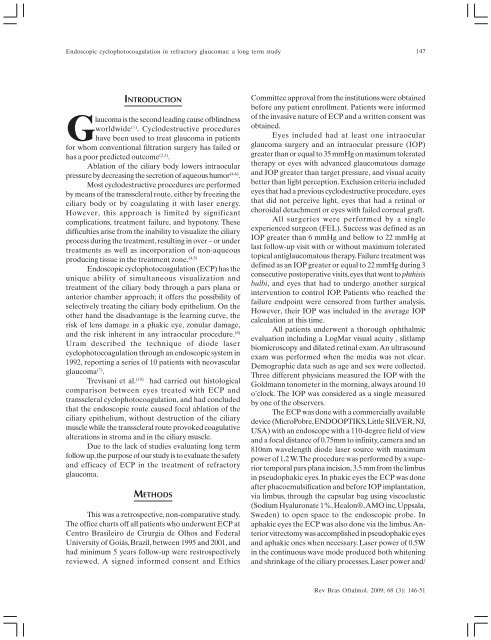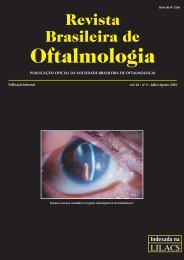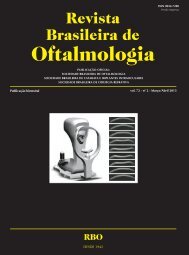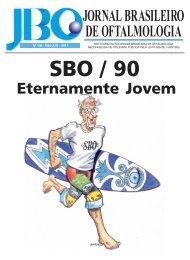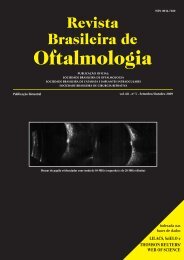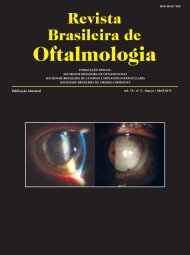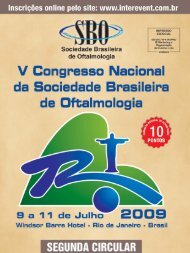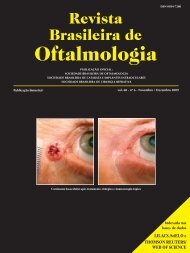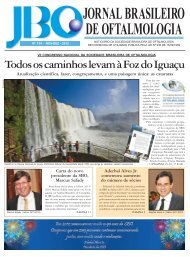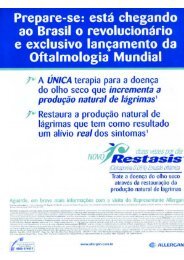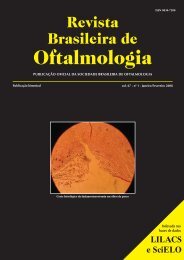Mai-Jun - Sociedade Brasileira de Oftalmologia
Mai-Jun - Sociedade Brasileira de Oftalmologia
Mai-Jun - Sociedade Brasileira de Oftalmologia
You also want an ePaper? Increase the reach of your titles
YUMPU automatically turns print PDFs into web optimized ePapers that Google loves.
Endoscopic cyclophotocoagulation in refractory glaucomas: a long term study<br />
147<br />
INTRODUCTION<br />
Glaucoma is the second leading cause ofblindness<br />
worldwi<strong>de</strong> (1) . Cyclo<strong>de</strong>structive procedures<br />
have been used to treat glaucoma in patients<br />
for whom conventional filtration surgery has failed or<br />
has a poor predicted outcome (2,3) .<br />
Ablation of the ciliary body lowers intraocular<br />
pressure by <strong>de</strong>creasing the secretion of aqueous humor (4-6) .<br />
Most cyclo<strong>de</strong>structive procedures are performed<br />
by means of the transscleral route, either by freezing the<br />
ciliary body or by coagulating it with laser energy.<br />
However, this approach is limited by significant<br />
complications, treatment failure, and hypotony. These<br />
difficulties arise from the inability to visualize the ciliary<br />
process during the treatment, resulting in over – or un<strong>de</strong>r<br />
treatments as well as incorporation of non-aqueous<br />
producing tissue in the treatment zone. (4,5)<br />
Endoscopic cyclophotocoagulation (ECP) has the<br />
unique ability of simultaneous visualization and<br />
treatment of the ciliary body through a pars plana or<br />
anterior chamber approach; it offers the possibility of<br />
selectively treating the ciliary body epithelium. On the<br />
other hand the disadvantage is the learning curve, the<br />
risk of lens damage in a phakic eye, zonular damage,<br />
and the risk inherent in any intraocular procedure. (8)<br />
Uram <strong>de</strong>scribed the technique of dio<strong>de</strong> laser<br />
cyclophotocoagulation through an endoscopic system in<br />
1992, reporting a series of 10 patients with neovascular<br />
glaucoma (7) .<br />
Trevisani et al. (10) had carried out histological<br />
comparison between eyes treated with ECP and<br />
transscleral cyclophotocoagulation, and had conclu<strong>de</strong>d<br />
that the endoscopic route caused focal ablation of the<br />
ciliary epithelium, without <strong>de</strong>struction of the ciliary<br />
muscle while the transscleral route provoked coagulative<br />
alterations in stroma and in the ciliary muscle.<br />
Due to the lack of studies evaluating long term<br />
follow up, the purpose of our study is to evaluate the safety<br />
and efficacy of ECP in the treatment of refractory<br />
glaucoma.<br />
METHODS<br />
This was a retrospective, non-comparative study.<br />
The office charts off all patients who un<strong>de</strong>rwent ECP at<br />
Centro Brasileiro <strong>de</strong> Cirurgia <strong>de</strong> Olhos and Fe<strong>de</strong>ral<br />
University of Goiás, Brazil, between 1995 and 2001, and<br />
had minimum 5 years follow-up were restrospectively<br />
reviewed. A signed informed consent and Ethics<br />
Committee approval from the institutions were obtained<br />
before any patient enrollment. Patients were informed<br />
of the invasive nature of ECP and a written consent was<br />
obtained.<br />
Eyes inclu<strong>de</strong>d had at least one intraocular<br />
glaucoma surgery and an intraocular pressure (IOP)<br />
greater than or equal to 35 mmHg on maximum tolerated<br />
therapy or eyes with advanced glaucomatous damage<br />
and IOP greater than target pressure, and visual acuity<br />
better than light perception. Exclusion criteria inclu<strong>de</strong>d<br />
eyes that had a previous cyclo<strong>de</strong>structive procedure, eyes<br />
that did not perceive light, eyes that had a retinal or<br />
choroidal <strong>de</strong>tachment or eyes with failed corneal graft.<br />
All surgeries were performed by a single<br />
experienced surgeon (FEL). Success was <strong>de</strong>fined as an<br />
IOP greater than 6 mmHg and bellow to 22 mmHg at<br />
last follow-up visit with or without maximum tolerated<br />
topical antiglaucomatous therapy. Failure treatment was<br />
<strong>de</strong>fined as an IOP greater or equal to 22 mmHg during 3<br />
consecutive postoperative visits, eyes that went to phthisis<br />
bulbi, and eyes that had to un<strong>de</strong>rgo another surgical<br />
intervention to control IOP. Patients who reached the<br />
failure endpoint were censored from further analysis.<br />
However, their IOP was inclu<strong>de</strong>d in the average IOP<br />
calculation at this time.<br />
All patients un<strong>de</strong>rwent a thorough ophthalmic<br />
evaluation including a LogMar visual acuity , slitlamp<br />
biomicroscopy and dilated retinal exam. An ultrasound<br />
exam was performed when the media was not clear.<br />
Demographic data such as age and sex were collected.<br />
Three different physicians measured the IOP with the<br />
Goldmann tonometer in the morning, always around 10<br />
o’clock. The IOP was consi<strong>de</strong>red as a single measured<br />
by one of the observers.<br />
The ECP was done with a commercially available<br />
<strong>de</strong>vice (MicroPobre, ENDOOPTIKS, Little SILVER, NJ,<br />
USA) with an endoscope with a 110-<strong>de</strong>gree field of view<br />
and a focal distance of 0.75mm to infinity, camera and an<br />
810nm wavelength dio<strong>de</strong> laser source with maximum<br />
power of 1.2 W. The procedure was performed by a superior<br />
temporal pars plana incision, 3.5 mm from the limbus<br />
in pseudophakic eyes. In phakic eyes the ECP was done<br />
after phacoemulsification and before IOP implantation,<br />
via limbus, through the capsular bag using viscoelastic<br />
(Sodium Hyaluronate 1%, Healon®, AMO inc, Uppsala,<br />
Swe<strong>de</strong>n) to open space to the endoscopic probe. In<br />
aphakic eyes the ECP was also done via the limbus. Anterior<br />
vitrectomy was accomplished in pseudophakic eyes<br />
and aphakic ones when necessary. Laser power of 0.5W<br />
in the continuous wave mo<strong>de</strong> produced both whitening<br />
and shrinkage of the ciliary processes. Laser power and/<br />
Rev Bras Oftalmol. 2009; 68 (3): 146-51


